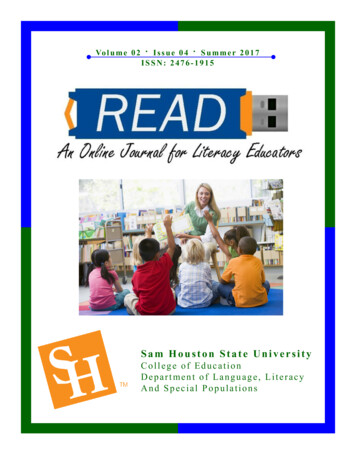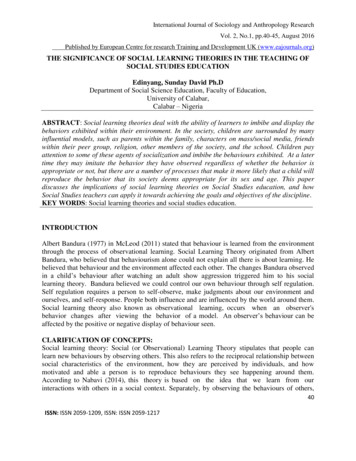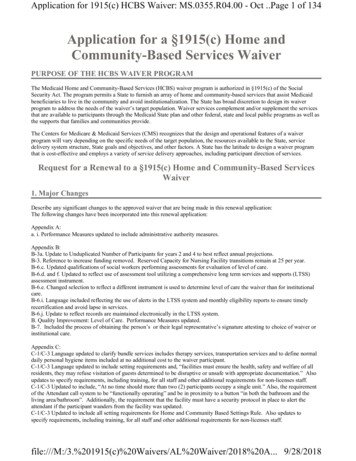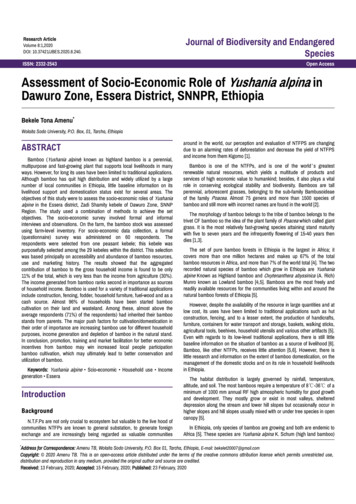
Transcription
Vo l u m e 0 2·Issue 04 · Summer 2017ISSN: 2476-1915Sam Houston State UniversityCollege of EducationDepartment of Language, LiteracyAnd Special Populations
Page 2ISSN: 2476-1915READ: An Online Journal for Literacy Educators – Vol. 2, Issue 4, Summer 2017Volume 2, Issue 4, Summer 2017Table of ContentsFeature Articles“You Mean that Really Happened?!”: Using Nonfiction to Engage Struggling ReadersCarolyn J. Stufft4Using Authentic Literature to Enrich Young Children’s Literacy ExperiencesKristi L. Dudley, Ramona T. Pittman, and Rebekah E. Piper9ColumnsCulturally Responsive Ideas from EducatorsStruggling Emerging Literacy Learners: The Importance of Text Selection andSupportive Book IntroductionJolene B. Reed18An Online Book Club with Graphic NovelsMae Lane and Jaime Coyne26Math ABC BookGladys Prieto32Sam Houston Writing Project: My Sister’s KeeperDianna Green40Fiction RapAshlyn Williams and Kelly Davis44Mathematics and Science Rap BattleKirsten Baston45Book Reviews48
READ: An Online Journal for Literacy Educators – Vol. 2, Issue 4, Summer 2017Page 3ISSN: 2476-1915EDITOR’S NOTE.Jacquelyn K. Vasquez , B.S.Graduate StudentSam Houston State UniversityLayout Editor, READ: An Online Journal for Literacy Educatorsread@shsu.eduDear Readers,The READ Editorial Team wants to thank all who submitted a manuscript!!We hope you enjoy reading the fourth issue of this journal. The theme for this issue is:(Re) envisioning Literacy for Struggling Readers.The theme for the December 2017 publication will be an un-themed issue. We invite Featur e Ar ticle and Column submissions that offer a variety of viewpoints and visions related to literacy in the21st century. The viewpoints and visions can be across multiple settings and modalities. This issuewill contain an assortment of articles that helps to expand our viewpoints and visions about literacyeducation and literacy practices.The theme for the June 2018 publication is: Literacy in a Social Justice Era. The deadline to submitfor the June publication is April 1, 2018.Please go to the website to review submission -literacy-and-special- populations/read-journal/We look forward to reading your manuscript!Sincerely,READ Editorial Team!!Founding Editor Benita R. Brooks, Sam Houston State UniversityLayout Editor Jacquelyn Vasquez, Sam Houston State UniversityEDITORIAL REVIEW BOARDBurcu Ates, Ph.D. Sam Houston State UniversityAlma Contreras-Vanegas, Ph.D. Sam Houston State UniversityDonna Cox, Ph.D. Sam Houston State UniversityElizabeth Lasley, Ph.D. Sam Houston State UniversityDiana Nabors, Ph.D. Sam Houston State UniversityRamona Pittman, Ph.D. Texas A&M San AntonioNancy Stockall, Ph.D. Sam Houston State UniversityNancy Votteler, Ed.D. Sam Houston State University
Page 4ISSN: 2476-1915READ: An Online Journal for Literacy Educators – Vol. 2, Issue 4, Summer 2017“You Mean that Really Happened?!”: Using Nonfiction toEngage Struggling ReadersCarolyn J. Stufft, Ed.D.Berry College—GeorgiaAbstractNonfiction texts used in a middle school classroom encouraged struggling readers to exploreother nonfiction texts and to write about theworld around them. Rosenblatt’s (1978) transactional theory of reader response posits that aninteraction takes place among reader, author,and text during reading. The nonfiction textsGuts: The True Stories Behind Hatchet and theBrian Books (Paulsen, 2001) and Night (Wiesel,2006) sparked students’ interest in real-life stories of survival and prompted struggling readersto read other nonfiction stories and to reflectupon and share text-to-self, text-to-text, and text-to-world connections through discussion andwriting.Keywords: nonfiction texts, struggling readers,middle school literacyRecently, I was fortunate enough to havean opportunity to return to the classroom toteach 6th, 7th, and 8th grade reading classes in asmall, rural district. I quickly discovered thatmy students were fond of series of the Twilightvariety and naturally gravitated toward fictionbooks on days that we visited the library. WhenI began using nonfiction texts in the classroom,I met with resistance from many students whotold me that nonfiction is “boring.” Otherschimed in that nonfiction passages are onlyfound on “those tests we take in the spring.”Over the course of a few days, some studentsconceded that nonfiction may be relevant intheir science and social studies classes butthat it was not something they would chooseto read. My struggling readers, in particular,voiced displeasure for nonfiction. These responses concerned me, not because I wantedto prepare students to ace the nonfiction comprehension questions on standardized testsbut because I wanted to help students appreciate nonfiction for what it is – an entranceinto other places, historical settings andevents, real people’s lives – a way to explorethe world around us.At first, I tried to select newspaper ormagazine articles that I thought would interest my students. A few articles were popularwith some of the students, but I could notseem to move the class toward that “lightbulb” moment when nonfiction became relevant and interesting. I focused particularly onmy 8th grade class because I wanted to prepare them for the more challenging texts theywould encounter in high school. I hoped thatmy quest would lead to ideas for engagingmy 6th and 7th grade students in nonfiction,too. Over the course of several days, I introduced one article after another without finding one that captured the attention of thewhole class. As I started to become discour-
READ: An Online Journal for Literacy Educators – Vol. 2, Issue 4, Summer 2017aged, I came across the nonfiction text Guts:The True Stories Behind Hatchet and the BrianBooks by Gary Paulsen. I knew that my 8th gradestudents had read Hatchet the year before andhad enjoyed it. I introduced Guts by asking thestudents to tell me what they remembered aboutHatchet. Although months had passed betweenthe time the students read the text in 7th gradeand the day I asked them to retell the story in 8thgrade, the students could relay an impressiveamount of detail. For the first time in weeks,they were excited to talk about reading, and thisencouraged me to move forward with the GaryPaulsen nonfiction text.I first asked the students to look carefully at the pictures on the front cover of Guts andto make predictions about the stories GaryPaulsen might share within the text. The 8thgraders quickly pointed to a photograph of sleddogs on the cover and were able to connect thepicture to other Paulsen books. Several struggling readers also joined the conversation bymaking personal connections with the picturesof Paulsen drawing back a bow string and casting a fishing line. I read aloud the first severalpages of the book, and then stopped to ask questions about the text. At the end of class, I askedstudents to complete a quick write reflecting onthe day’s reading. I was pleasantly surprised tosee that each student was able to write something based on the passage from Guts. The nextseveral class periods followed a similar pattern– I would read aloud, sometimes pausing tothink aloud, other times pausing to ask questionsand allow for discussion. Each class ended witha quick write; over time, I noticed that the students had more and more to say in their writing,so quick writes evolved into full-length journalentries.According to Rosenblatt (1978), readersrespond to reading in unique ways because eachPage 5ISSN: 2476-1915individual possesses a unique set of background knowledge and experiences. A centraltenet of the transactional theory of reader response is that an interaction takes placeamong reader, author, and text (Hancock,1993; Rosenblatt, 1978). Based on this theory, nonfiction texts may represent a way tointroduce students to a topic or experiencethat may lead to different reactions or interpretations that can be shared in class discussions and through writing.Later in the week, we read a passagein which Paulsen describes himself and hissled dogs being rescued from terrible weatherby a pilot flying a small Cessna plane. In thedescription, Paulsen first explains that he hadto pull and throw his entire team of fourteensled dogs, still harnessed together, into theplane. Once inside, the engine noise frightened the dogs, who attempted to run awayfrom the sound; this movement caused thetail of the plain to tip and required Paulsen totoss the dogs toward the front of the plain toeven the weight distribution. Paulsen goes onto explain that each time he threw a dog toward the front of the plane, the dog would gorunning toward the tail once more. Paulsen“threw another, then another, then another,every time hitting the pilot, who was swearing at me and screaming at the dogs” (2001,p. 25). My students reacted with incredulityand laughter to the seemingly absurd events.Several struggling readers, in particular, cameto life while reading this description.When it was time for students to writeabout their reading at the end of class, all decided to write about the plane rescue scene.One student asked if it was okay to connectthe passage to a movie he saw that depicted aplane crash. The student reasoned that hecould only really connect with TV or movies
Page 6ISSN: 2476-1915READ: An Online Journal for Literacy Educators – Vol. 2, Issue 4, Summer 2017because the story “wasn’t real.” This commentled to an energetic discussion of Paulsen’s experiences, with others in the classroom remindingone another that nonfiction text describes realevents. After several minutes of debate regarding the plane rescue story, the students agreedthat it had really happened and were even moreintrigued and impressed with Paulsen’s life. Asthe students returned to their writing, one struggling reader who had been particularly quietduring the class discussions that day blurted,“You mean that really happened?!” This studentwent on to explain that he thought nonfictionwas just a more descriptive, less imaginativetype of fiction until the class discussion sank inthat day. This observation spurred the class intoanother discussion of what it might have beenlike to really live through the experiences weread about. Realizing that the nonfiction textwas true engaged struggling readers in the storyto an even greater extent.Following that day’s discussion, the students began searching on their own for nonfiction texts related to the Iditarod and wildernesssurvival tales; several began reading aboutplanes and helicopters. The use of the nonfictiontext Guts provided an entryway for me to bringnonfiction articles into the classroom oncemore; this time, the articles were met with awarm reception because the students were motivated to read more about sled dogs, snowstorms, surviving in the wild, and other nonfiction topics related to the true tales told in Guts.Students then were interested in moving beyondquick writes and journal entries, asking if theycould write “reports” based on articles and othernonfiction text they read related to wildernesssurvival and the topics included in Paulsen’stext. As we continued to read Guts in class, students began reading more nonfiction on theirown outside of class and chose to write abouttheir reading using a variety of genres. At onepoint, the students asked if our class couldcreate a survival newsletter that presentedoverviews of real-life wilderness survival stories, along with tips for living in the wild.The use of nonfiction text encouraged students not only to read nonfiction but to writeabout the world around them.Our reading of Guts also guided theclass to another nonfiction text on a differenttopic. In one particularly poignant passage ofGuts, Paulsen talks about his time as anemergency medical technician in a rural areaand recounts the experience of arriving toolate to save a heart attack victim. In the passage, Paulsen mentions the “thousand-yardstare” visible in the patient’s eyes (2001, p.4). My students were initially puzzled by theexpression, so we paused to think about thephrase. Several students made a connectionwith the length of a football field and calculated that it would take ten fields to make athousand yards. One student asked if it waspossible to really see anything that far away.The conversation moved back to the passage,and another student mentioned that the patient was probably staring at the ceiling,which would have been much closer than athousand yards. Over the course of severalminutes of thoughtful consideration and discussion, the students came to understand thatthis expression related to the look of a personwho had experienced severe trauma; in thiscase, a person who was near death. The classended on a somber note that day, but the nextday students came in buzzing about the expression. Several students had searchedonline for more information about the thousand-yard stare and had asked parents andgrandparents about the phrase the eveningbefore. One student brought in a copy of the
READ: An Online Journal for Literacy Educators – Vol. 2, Issue 4, Summer 2017book The Two Thousand Y ard Stare: TomLea’s World War II (Lea, 2008) and shared withthe class pictures of the USS Gleaves and theUSS Zircon contained in the book. Finally mystudents, including struggling readers, were notonly making text-to-self connections but alsomaking text-to-text and text-to-world connections.My class finished reading Guts, not withrelief to have finished a nonfiction text but withregret that the stories had ended. The studentsasked to read more nonfiction and returnedagain to the thousand-yard stare phrase, askingto read something that connected with the expression. I had planned to move on to the topicof the Holocaust later that year, but encouragedby my struggling readers’ interest in nonfictiontext, I decided it was time for the class to surgeforward and read Night (Wiesel, 2006). I usedthe picture book Terrible Things: A n A llegoryof the Holocaust (Bunting, 1989) to spark discussion before beginning Night. The fictionalpicture book Terrible Things relates to theevents of the Holocaust and prepared studentsfor reading Night. The use of a picture book surprised my students, with several commentingthat they had not read a picture book, or had oneread to them, since early elementary school.However, the picture book provided a way forme to introduce a complex topic by using a textthat was accessible to all of my students.Throughout the next several weeks of reading,Night sparked students’ interest in reading moreabout World War II in general and the Holocaust in particular. Students searched for information online and looked for nonfiction booksduring library visits to learn more about thistime in history. They also made connectionswith their history class and started to see theways in which nonfiction can be more than atextbook chapter or a standardized test passage.Page 7ISSN: 2476-1915Together, we viewed pictures of concentration camps, maps of 1940s Europe, andread passages written by Anne Frank. Thecontent of Night encouraged my 8th graders toexplore more about this time in history andthe people who were part of it. Throughoutthe rest of the school year, students wouldbring to class books that they found or articles they came across related to World WarII. Through their own reading, students explored topics such as the Danish Resistanceand shared their new knowledge with theclass. One student came across an articleabout Simon Wiesenthal and Adolf Eichmannand read more information on the website forthe Simon Wiesenthal Center. In response, Iincorporated the picture book The A nneFrank Case: Simon Wiesenthal’s Search forthe Truth (Rubin, 2010). After reading thebook to my 8th grade class, I used the textwith my 6th graders and found it to be a dynamic way to engage them in nonfiction, too.Night provided content that led mystudents to create character mind maps and towrite diary entries from the point of view of aHolocaust survivor. Students also wrote letters to Elie Wiesel, as well as to other historical figures from the era, such as Anne Frank;although the recipients could not write back,my students were able to communicate theirquestions through a letter-writing variety ofQuestion the Author (QtA). Through readingboth Guts and Night, students became interested in reading more nonfiction and also inwriting about these texts. From brief quickwrites to more in-depth journal responses,letters, reports, and newsletters, students explored their text-to-self, text-to-text, and textto-world connections stemming from nonfiction texts. Through thought-provoking nonfiction stories, my middle school students
Page 8ISSN: 2476-1915READ: An Online Journal for Literacy Educators – Vol. 2, Issue 4, Summer 2017were able to think about their world and to writeabout the world around them. These nonfictiontexts and the associated writing activities engaged my struggling readers in ways that weremeaningful and that extended far beyond thetraditional nonfiction text associated with standardized testing.ReferencesBunting, E. (1989). Terrible things: A n allegoryof the Holocaust. Philadelphia, PA: JewishPublication Society.Hancock, M. R. (1993). Exploring the meaningmaking process through the content of literature response journals. Research in theTeaching of English, 27(4), 335-368.Lea, T. (2008). The two thousand yard stare:Tom Lea’s World War II. B. M. Greeley, Jr.(Ed.). College Station, TX: Texas A&MUniversity Press.Paulsen, G. (2001). Guts: The true stories behind Hatchet and the Brian books. NewYork, NY: Dell Laurel-Leaf.Paulsen, G. (1987). Hatchet. New York, NY:Aladdin Paperbacks.Rosenblatt, L. M. (1978). The reader, the text,the poem: The transactional theory of theliterary work. Carbondale, IL: Southern Illinois University Press.Rubin, S. G. (2010). The A nne Frank case: Simon Wiesenthal’s search for the truth. NewYork, NY: Holiday House.Wiesel, E. (2006). Night (Marion Wiesel,Trans.). New York, NY: Hill and Wang.(Original work published 1972).Author’s BiographyCarolyn J. Stufft is an assistant professor ofTeacher Education at Berry College in Georgia. She received her doctorate in literacy,with an emphasis in digital literacies, fromSam Houston State University. She is a certified English/Language Arts/Reading (ELAR)teacher, Reading Specialist, and MasterReading Teacher; she has taught grades 4-8in charter and Title I public schools. Her research interests include the use of digital literacies to promote tweens’ and teens’ literacypractices. She is interested in preparing preservice teachers to effectively incorporatenew literacies within the curriculum.CorrespondenceAll correspondence should be sent to CarolynStufft at cstufft@berry.edu or Berry College,2277 Martha Berry Hwy NW, P.O. Box495019, Mt. Berry, GA 30149-5019. Voicecalls should be made to 706-368-6703.
READ: An Online Journal for Literacy Educators – Vol. 2, Issue 4, Summer 2017Page 9ISSN: 2476-1915Using Authentic Literature to Enrich Young Children’sLiteracy ExperiencesKristi L. Dudley, M.S.Ramona T. Pittman, Ph.D.Rebekah E. Piper, Ph.D.Texas A&M University—San AntonioAbstractThis article focuses on the five components(phonemic awareness, phonics, fluency, vocabulary, and comprehension) needed to effectivelyteach children to read. Early childhood educators can teach these five skills through the use ofauthentic literature. To be classified as authentic literature, books and texts need to utilize“real life” writing that is written to engage thereader. Authentic narrative texts generally appeal to the reader and offers a theme and a moral to the story. The article explains the five components needed to teach children to read andoffers some authentic texts, synopses, and lessonideas specifically for each of the components.Although children may not be able to read thetexts, the texts selected are at the child’s listening comprehension level. In addition, the selected texts will aid early childhood educatorsand parents in infusing these skills for engagingimplementation.Keywords: authentic literature, phonemicawareness, phonics, fluency, vocabulary, comprehensionLiteracy is an essential skill to development in the early years (Pittman, 2014).When preparing young children for educational success, one can use children’s literature to help promote the five components ofeffective reading instruction (National Reading Panel, 2000). The National Reading Panel stated that phonemic awareness, phonics,fluency, vocabulary, and text comprehensionare needed to be able to successfully teachchildren to read. Most school agencies anddistricts build their literacy curricula aroundthese five pillars. Prior to kindergarten, earlychildhood educators should use authenticchildren’s literature to cultivate these skills inyoung children.Authentic literature is characterizedby “real life” writing that is written for thesole purpose of emotionally engaging thereader. Authentic literature can be narrativeor expository and include texts that are usually enjoyed outside of a classroom (PurcellGates & Duke, 2004). Authentic literaturedoes not specifically seek to provide fundamental reading instruction and for this veryreason, can be used as a powerful instructional tool (Duke, Purcell-Gates, Hall, & Tower,2006/2007). When parents read bedtime stories to their children, they tend to automati-
Page 10ISSN: 2476-1915READ: An Online Journal for Literacy Educators – Vol. 2, Issue 4, Summer 2017cally read authentic literature. These stories generally are fun for the child to listen to and allowthem to use their imagination. This sort of engagement is the first step to molding the childinto becoming an aesthetic reader. Aestheticreaders read for pleasure and, as noted by Applegate and Applegate (2004), “see reading asactive immersion into a text and the opportunityto live vicariously through the situations andlives of its characters” (p. 554)Furthermore, educators can continue tonurture children’s love for literature by intertwining the components of reading with authentic literature to achieve the main goal of creatingstrong, future readers. In order to understandhow authentic literature can be used to incorporate the five pillars of reading, each pillar shouldbe explained.Phonemic awareness is a component of alarger umbrella term, phonological awareness.Phonological awareness is the ability to manipulate sounds in spoken language (Yopp & Yopp,2009). Phonological awareness skills from easiest to most difficult include: 1) hearing rhymingwords (e.g., cat, hat, mat, flat) and alliteration(e.g., The blue bike is broken.), 2) segmentingsentences to hear that sentences are made up ofindividual words (e.g., She is happy. is comprised of three words), 3) onset and rime blending and segmenting (e.g., /d/ og dog), andphonemic awareness.Phonemic awareness is the highest skilllevel on the phonological awareness continuum.Phonemic awareness is defined as the ability tonotice, think about and manipulate individualsounds or phonemes in words (e.g., Dog hasthree phonemes or individual sounds, /d/ /o/ /g/(Armbuster, Lehr, & Osborne, 2001). Accordingto the National Reading Panel, a child’s abilityto complete phonemic awareness tasks is thegreatest predictor of success in reading duringthe first two years of school. To enhancethese skills, early childhood educators shouldselect children’s books written using simple,rhyming words and/or words that focus onparticular sounds and word play which canteach children how to manipulate sounds toform different words in engaging ways.Secondly, the approach to teachingletter-sound correspondence is called phonics. During phonological awareness tasks,children would have been manipulatingsounds in spoken language. Phonics combines written language with spoken languageso that children will learn to decode words inprint by mapping speech to print (Moats,2010). Phonics instruction begins with letterrecognition, letter-sound correspondence, andsight word activities. Phonics instruction advances to teach students how to read wordswith multiple syllables. Early childhood educators, however, should focus on the firstthree skills.Moreover, fluency is the ability toread connected text accurately, quickly, expressively, with good phrasing and goodcomprehension (Rasinski & Nageldinger,2015). When a fluent reader can accuratelyand quickly decode words with automaticity,the reader can, therefore, focus his efforts oncomprehending what is being read. As withany skill, once a student’s literacy skills haveevolved enough, they become almost automatic, to the point where the student no longer has to focus his attention on recognizingthe fundamentals, but instead can see thewhole “picture”. Fluency brings text to lifeand introduces students to the endless potential uses for literature. Authentic literaturerepresents examples of each of these possibilities. Early childhood educators can helpyoung children to understand fluency by
READ: An Online Journal for Literacy Educators – Vol. 2, Issue 4, Summer 2017modeling reading at a conversational rate andusing appropriate expression. Authentic literature that provides dialogue is an excellent wayto practice these skills.Next, vocabulary is understanding themeanings of words. Beck, McKeown, and Kucan (2013) state “ a large vocabulary repertoire facilitates becoming an educated person tothe extent that vocabulary knowledge is stronglyrelated to reading proficiency in particular andschool achievement in general” (p. 1). Knowingthe meaning of words is essential to listeningand reading comprehension. Early childhoodeducators should choose books that include awide range of vocabulary so children can be immersed in good vocabulary. Beck et al., providean explanation for teaching vocabulary to children. The authors suggest by placing words intiers (Tier, 1, 2, and 3), a teacher would knowwhich words to teach students. Tier 1 words arebasic, everyday words that children shouldknow; therefore, the words do not have to betaught (e.g., baby, table, car). (Please note thatthese words may need to be taught for EnglishLanguage Learners or students with limited vocabulary knowledge and experiences.) Tier 2words are words frequently used in language,are central to comprehension, and are understood by most mature language users (e.g., gigantic, sophisticated, ecstatic) (Honig, Diamond, & Gutlohn, 2008). Tier 3 words arethose words that are generally used within thecontent of study (e.g., altitude, longitude, peninsula). Although young children may not be ableto read, authentic literature provides studentswith ample opportunities to hear good Tier 2words, which helps build their knowledge ofwords and aid in comprehension.Reading comprehension is the ultimategoal of why we read. Without understandingwhat the author is telling the reader, the wordsPage 11ISSN: 2476-1915on the page are useless. The RAND StudyGroup defines reading comprehension as “theprocess of simultaneously extracting and constructing meaning through interaction andinvolvement with written language” (Kirby,2002, p. 11). Authentic literature is the ultimate tool for enhancing reading comprehension because it encompasses such a large variety of writing styles and topics. Early childhood educators should use authentic literaturebecause books with good storylines aid in thedevelopment of comprehension. These bookstend the have great characters and a good plotwith a problem, a solution, and a sequence ofevents.All pillars of reading are necessary toensure young children’s success in learningto read. The following is a list of authentictexts that can be used with young children tohelp develop their literacy skills in each ofthe five pillars of reading.Phonemic AwarenessAndreae, G., & Parker-Rees, G. (2001).Giraffes can't dance. New York: OrchardBooks.Synopsis of Literature:Gerald is a clumsy giraffe. He wantsto dance at the yearly jungle dance but isashamed of his awkward dancing, and theother animals make fun of him. With the helpfrom a friend, Gerald is able to overcome hisfear and discovers that he truly can dance.Lesson Idea:Giraffes Can’t Dance is a great bookfor developing phonemic awareness usingrhyming words. When the teacher reads thebook aloud to the class, the students will be-
Page 12ISSN: 2476-1915READ: An Online Journal for Literacy Educators – Vol. 2, Issue 4, Summer 2017come familiar with the rhythm and rhyme pattern of the text. During the next read, the teachershould have the class determine which wordsrhyme. Last, the students should toss a ball toeach other, and once the ball is caught, theyshould say a word that rhymes with the previousstudent’s word.Seeger, L. V. (2005). W alter was worried.New Milford, CT: Roaring Brook Press.Synopsis:In this fun text, W alter was worried ,Priscilla was puzzled , and Shirley wasshocked, each character is in a mood that startswith the same sound (phoneme) as their firstname.Lesson Idea:Teachers can use this book to teach phonemic awareness. One of the major skills thatwill be taught in kindergarten is the ability toisolate the initial or first sound in words, suchas /v/ in van or /sh/ in ship. This is an excellentbook to have young children develop a sentencebased upon the initial sound of their name (e.g.,Holly was happy.). Next, the children can drawa picture similar to the cover page of W alterWas Worried. The picture should help illustratetheir sentence.PhonicsShaw, N., & Apple, M. (1986). Sheep in ajeep. Boston, MA: Houghton Mifflin Company.Synopsis:In this story, a group of sheep run intosome trouble while driving their jeep, and thefurther they
An Online Book Club with Graphic Novels Mae Lane and Jaime Coyne 26 Math ABC Book Gladys Prieto 32 Sam Houston Writing Project: My Sister’s Keeper Dianna Green 40 Fiction Rap Ashlyn Williams and Kelly Davis 44 Mathematics and Science Rap Battle Kirsten Baston 45 Columns C










